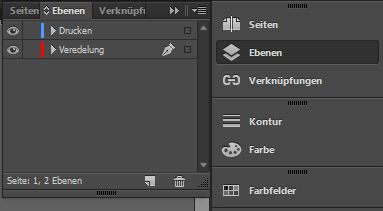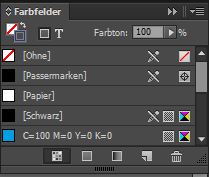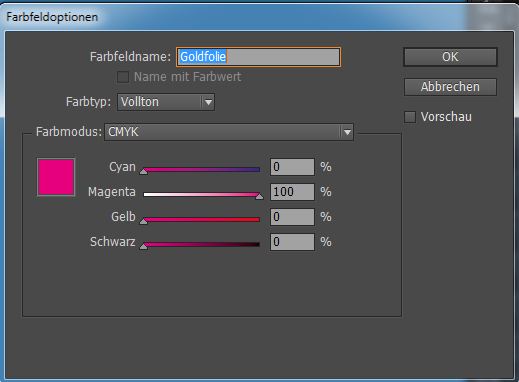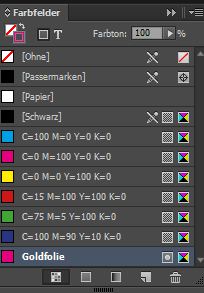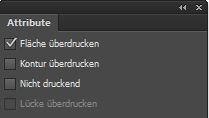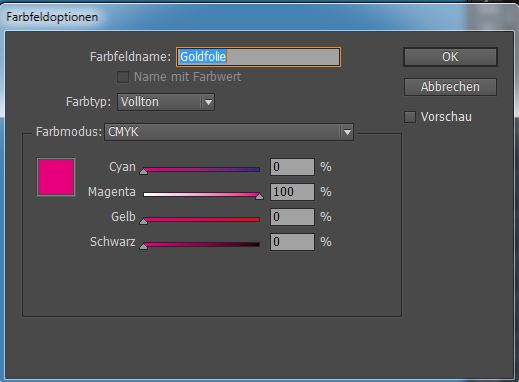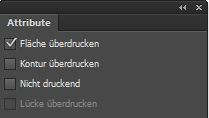Wenn Du PDFs zum Hochladen für den anschließenden Druck erstellst, nutze bitte anerkannte PDF Generatoren, wie beispielsweise Acrobat Distiller. Wenn Du einen PDF-Generator nutzt, der in Deiner Design Suite inklusive ist, kann das dazu führen, dass Deine Daten abgelehnt werden. Speichere sie immer in hoher bzw. Druckqualität ab. Wenn Du Acrobat Distiller nutzt, wähle im Dropdown PDF/X-la:2001. Wenn Du Deine PDF's erstellst, achte bitte darauf, dass alle Schriftarten sauber eingebettet sind.
Schau Dir PDFs immer mit der Ausgabevorschau an, bevor Du sie zum Druck hochlädst. Dadurch siehst Du die genaueste Abbildung davon, wie es gedruckt aussehen wird und Fehler, die vorher nicht sichtbar waren, kommen durch die Ausgabevorschau unter Umständen noch zum Vorschein.
Die Richtlinien zu den Dateiformaten findest zu zusätzlich als PDF hier.
Du tust Dich schwer bei der Nutzung von InDesign oder Illustrator? Du würdest gerne Deine Druckdaten richtig anlegen, hast aber keine Ahnung wie du den Beschnitt für Deine Druckdatei einstellen sollst?
Dann haben wir hier genau das Richtige für Dich!
Wir haben Dir hier eine kleine Anleitung zusammengestellt. Damit solltest Du das Problem in den Griff bekommen. :)
Beginnen wir mit InDesign.
Schritt 1: Das Dokument über Datei > Neu > Dokument einrichten und unter "Anschnitt und Infobereich" 3mm Beschnitt eingeben.
Schritt 2: Im normalen Modus wird Dir jetz ein roter Rahmen angezeigt, der den Beschnitt markiert.
Jetzt ist es wichtig, dass Du alle Bilder und Grafiken bis mindestens an den roten Rand platzierst. Ansonsten können nämlich weiße Blitzer entstehen.
Schritt 3: Beim Exportieren als PDF unter dem Menüpunkt "Marken und Aschnitt" das Häkchen bei "Anschnitteinstellungen des Dokuments verwenden". Achte darauf kein Häkchen bei Marken zu setzen.
In Illustrator sieht die ganze Sache ähnlich aus.
Schritt 1: Lege ein neues Dokument an (Datei > Neu).
Anschließend gibst Du unter "Anschnitt" 3mm Beschnitt an.
Schritt 2: Im normalen Modus wird Dir jetzt ein roter Rahmen angezeigt, der den Beschnitt markiert.
Jetzt ist es wichtig, dass Du alle Bilder und Grafiken bis mindestens an den roten Rahmen platzierst. Ansonsten können weiße Blitzer entstehen.
Schritt 3: Beim exportieren als PDF unter dem Menüpunkt "Marken und Anschnitt" das Häkchen bei "Anschnitteinstellungen des Dokuments verwenden". Achte darauf kein Häkchen bei Marken zu setzen.
Fertig!
Du würdest gerne Deine Flyer mit einer Veredelung aufpeppen hast aber keine Ahnung wie du die Volltonfarbe für eine Veredelung anlegst? Du tust Dich schwer mit Programmen, wie InDesign und Illustrator?
Dann haben wir hier genau das Richtige für Dich!
Wir haben Dir eine kleine Anleitung zusammengestellt. Damit solltest Du das Problem in den Griff bekommen. :)
Schritt 1: Erstelle Dein Wunschprodukt mit Layout, Grafik- und Textelementen.
Schritt 2: Als nächstes erstellst Du eine neue Ebene. Hierzu gehst Du auf "Ebenen" und klickst auf "Neue Ebene erstellen". Anschließend benennst Du sie um (Doppelklick auf Ebene):
Ebene 1 > "Drucken"
Ebene 2 > "Veredelung"
Schritt 3: Auf dieser neuen Ebene ("Veredelung") fügst Du jetzt alle Elemente ein, die Du veredeln möchtest. Am einfachsten geht das, wenn Du die entsprechenden Elemente aus der "Drucken"-Ebene in die "Veredelung"s-Ebene kopierst und an der "Originalposition einfügst" (Rechtsklick, dann erscheint die Option).
Schritt 4: Im Fenster "Farbfelder" ein "Neues Farbfeld" erstellen.
Schritt 5: Im Fenster "Neues Farbfeld" (Doppelklick auf neues Farbfeld) den Farbtyp "Vollton" auswählen, den Farbmodus "CMYK" wählen und den Magenta-Farbkanal auf 100 % stellen.
Dem Farbfeld einen Namen geben (z. B. "Goldfolie"). Im Fenster "Farbfelder" erscheint jetzt der zusätzliche Farbkanal.
Wichtig hierbei: Bitte nur die folgenden Benennungen für Sonderfarben verwenden: Goldfolie, Silberfolie, Kupferfolie, Relieflack oder UV-Lack.
Jede andere Bezeichnung wird von der Scodix nicht erkannt!
Schritt 6: Die Elemente auf der neuen Ebene, die veredelt werden sollen, mit diesem neuen Farbkanal einfärben und abschließend im Fenster Attribute auf "Fläche überdrucken" bzw. "Kontur überdrucken" stellen. Dazu einfach die entsprechenden Elemente markieren und ein Häkchen in das jeweilige Feld setzen.
Schritt 7: Achte beim Exportieren darauf, dass in der Rubrik "Ausgabe" unter "Farbkonvertierung" der Befehl "Keine Farbkonvertierung" eingestellt ist. Um das zu kontrollieren öffnest du den Druckfarben-Manager", wo unter "Druckfarbe" der neue Farbkanal aufgeführt sein sollte.
Un wenn Du schon dabei bist, kannst Du auch sicherstellen, dass kein Häkchen bei "Alle Volltonfarben in Prozessfarben umwandeln" gesetzt ist.
Fertig! Jetzt sollte Deinen Veredelungen nichts mehr im Wege stehen.
Du würdest gerne Deine Flyer mit einer Veredelung aufpeppen hast aber keine Ahnung wie du die Volltonfarbe für eine Veredelung anlegst und auf Überdrucken stellst? Du tust Dich schwer mit Programmen, wie InDesign und Illustrator?
Dann haben wir hier genau das Richtige für Dich!
Wir haben Dir hier eine kleine Anleitung zusammengestellt. Damit solltest Du das Problem in den Griff bekommen. :)
Schritt 1: Alle zu veredelnden Elemente auf einer separaten Ebene "Veredelung" anlegen.
Schritt 2: Die Farbe, je nach Veredelungsoption, benennen und als Volltonfarbe (Farbwert: 100 % Magenta) anlegen.
Beispiel: Goldfolie
Schritt 3: Wenn Du Deine Druckprodukte veredeln möchtest, musst Du darauf achten, dass die "Überdrucken"-Option für die entsprechenden Elemente ausgewählt ist.
Wir empfehlen Dir außerdem die Überdruckenvorschau zu aktivieren, dann kannst Du noch bevor Du die Datei drucken lässt kontrollieren, ob das Endergebnis so aussieht, wie Du das wolltest.
InDesign:
1. Überdruckenvorschau in der Menü-Ansicht aktivieren (Strg+Alt+Umschalttaste+Y)
2. Wähle das gewünschte Element aus (in unserem Fall das Farbfeld mit der angelegten Volltonfarbe) das alle anderen Elemente überdrucken soll und setze das Häkchen im Attribute-Fenster bei "Fläche überdrucken". Ggf. kann es auch "Kontur überdrucken" heißen.
Zum Attribute-Fenster kommst Du so: "Fenster" > "Ausgabe" > "Attribute"
Illustrator:
Vom Ablauf ist es hier genauso, wie in InDesign. Nur die Bedienfelder sehen etwas anders aus.
1. Überdruckenvorschau im Ansicht-Menü aktivieren (Strg+Alt+Umschalttaste+Y)
2. Das Farbfeld "Sonderfarbe" auswählen und im Attribute-Fenster das Häkchen bei "Fläche überdrucken" setzen.
Fertig! Jetzt steht Deiner Veredelung nichts mehr im Wege.
Abweichende Absenderadresse? Kein Problem.
Eine neutrale Versendung an eine abweichende Lieferadresse direkt anDeinen Endkunden ist innerhalb des Liefergebiets möglich. Unterhalb den <Einstellungen> und <Rechnungsadresse> findest du die Option der "White-Label Lieferung". Aktiviere diese um auf dem Lieferschein und auf dem Versandlabel als Absender in Erscheinung zu treten.*
Als Absenderadresse wird die von Dir hinterlegte Rechnungsadresse verwendet und auf dem Versandlabel abgebildet.
Eine Vorlage des dem Paket mitgesendeten Lieferscheinsfindest du hier.
*gilt nur, wenn die Rechnungsadresse in Deutschland liegt
Hier erfährst du alles, was bei der Anlage einer Veredelung (Gold-, Silber- und Bronzefolie sowie UV- und Relieflack) beachtet werden soll: Datenblatt_Veredelung_Folie+Lack
Wie müssen Elemente korrekt für den Druck vorbereitet werden?
Bilder: Versuche uns die bestmögliche Qualität zu liefern. Der Standard hierfür ist eine Auflösung von 300 dpi (dots per inch). Je kleiner der dpi-Wert, desto schlechter ist die Auflösung der gedruckten Produkte. Behalte das bitte immer im Hinterkopf, wenn Du Bilder für Dein Projekt scannst, bearbeitest oder generell nutzt.
Schriftart / Fonts: Wir empfehlen eine minimale Schriftgröße von 5pt. Bitte benutze ausschließlich 100% schwarz,wenn der Text zwischen 5pt und 7pt liegt.
Bitte stelle sicher, dass alle Schriften in der PDF eingebettet sind oder alternativ in Pfade konvertiert sind. Nicht eingebettete Schriften sind ein absolutes K.O.-Kriterium bei der Produktion deines Produktes.
Die entsprechenden Richtlinien zur Datenanlage als PDF findest du hier.
Wie können unvermeidliche Farbabweichungen beim Druck minimiert werden?
Toleranzbereich: Durch den Toleranzbereich der Tinte in Verbindung mit 4-farbigem Druck, sind minimale Abweichungen bei finalen Druckprodukten unvermeidlich.
Dein Auftrag wird also innerhalb des Toleranzbereichs und natürlich auch nach ISO Standards gedruckt; die finale Farbe kann allerdings trotzdem etwas anders aussehen, als Du es erwartet hast bzw. sie ist evtl. nicht 100% so wie die Originalfarbe in Deinen Designs.
Manchmal kann es auch innerhalb desselben Auftrags zu leichten Farbabweichungen kommen, die allerdings immer im Toleranzbereich liegen.
Nachfolgende Prints können wiederum leicht von vorherigen Druckvorgängen abweichen, was allerdings ganz normal ist und natürlich immer innerhalb des Toleranzbereichs bleibt.
Bildschirmfarben: Wenn Du Deine Projekte am Bildschirm ansiehst, schaust Du immer auf Farbkombinationen aus rotem, grünem und blauem Licht. Diese können nicht exakt so auf Papier wiedergegeben werden. Wie Du die Farben wahrnimmst, hängt außerdem sehr davon ab, wie Dein Monitor eingestellt ist.
Bitte beachte, dass die Farbe bzw. der Inhalt Deiner PDF, so wie sie auf dem Bildschirm aussieht, variieren kann, je nachdem, welches Simulationsprofil Du nutzt, um sie in Acrobat anzusehen. Bitte stelle deshalb sicher, dass Du kein Simulationsprofil für eine webbasierte Druckmaschine nutzt.
Versichere Dich außerdem vor dem Upload, dass alle Volltonfarben in Prozessfarben umgewandelt sind.
Farbstreifen: Wir empfehlen Dir, große, mit Farbe gefüllte Flächen, die ausschließlich aus Cyan, Yellow, Magenta oder Schwarz bestehen, zu vermeiden, da diese prädestiniert dafür sind, Farbstreifen zu bilden. Versuche bitte, Farbfüllungen zu benutzen, die aus zwei oder mehr der genannten Farben bestehen, um beste Printergebnisse zu erzielen.
Eine Zusammenfassung der Farbabweichungsthematik findest du zusätzlich hier.
Cellophanieren ist ein Druckveredelungsverfahren das auch als Folienkaschierung bekannt ist und sich besonders bei Werbemitteln wie Broschüren, Visitenkarten und Flyern bewährt hat. Bei der Cellophanierung werden die Oberflächen der Druckprodukte durch die Beschichtung mit einer hauchdünnen Folie veredelt.
Eine Cellophanierung oder Folienkaschierung kommt auch immer dann zum Einsatz, wenn es darum geht, Druckerzeugnissen ein hochwertiges Erscheinungsbild zu verleihen. Durch die Cellophanierung gewinnen die Oberflächen nicht nur Glanz, sondern auch eine angenehme, exklusive Haptik.
Gleichzeitig sind sie vor Flecken, Kratzern und Feuchtigkeit durch die Beschichtung optimal geschützt.
Wie wird eine Cellophanierung vorgenommen?
Als Cellophanierungsmaterial wird meist eine transparente Kunststofffolie eingesetzt. Sie kann für die Veredelung aller Sorten und Stärken von Papieren verwendet werden. Die Folien zur Papier-Veredelung gibt es sowohl in glänzenden als auch in matten Varianten. Zum Aufbringen der Folie ist ein Kaschiermittel erforderlich, das die Beschichtung auf der Papieroberfläche fixiert. Hierzu dienen Dispersions- oder Lösungsmittelkleber.
Die Cellophanierung von Papier kann in Form einer Nass- oder Thermokaschierung vorgenommen werden. Bei einer Nasskaschierung wirken auf den Klebstoff Druck und Wärme ein. Hierdurch verbinden sich die darin enthaltenen chemischen Lösungsmittel oder das Wasser von Dispersionsklebern dauerhaft mit der Folie und den Strukturen der Papiere, die beschichtet werden sollen. Bei einer Thermokaschierung wird der Kleber durch Wärmeeinwirkung aufgeschmolzen, erst danach werden Kaschiermittel und Folie unter Druck auf die Papierprodukte aufgebracht.
Folienveredelungen funktionieren auch ohne Hitze. Beim Kaltfolientransfer, einem jüngeren Druckverfahren, entstehen ähnliche Veredelungen wie bei der Heißfolienprägung. Jedoch kommt das Verfahren ohne Hitze oder Druck aus. Entsprechend wird der Druckstoff bei diesem Verfahren üblicherweise auch nicht verformt. Stattdessen wird hier, dem Motiv entsprechend, ein spezieller Kleber auf den Bedruckstoff aufgetragen. Anschließend wird eine Folie auf den Druckstoff übertragen und bleibt dort an den mit Kleber beschichteten Stellen haften.
Was sind die Vorteile des Kaltfolientransfers?
Durch die Kombination verschiedener Folien wie Gold-, Silber- oder Kupferfolie und Farben lassen sich beeindruckende neue Farbtöne erzeugen. Außerdem überzeugt das Verfahren gegenüber der Heißfolienprägung mit hoher Randschärfe und der Realisierbarkeit von sehr filigranen Elementen. Da die Technologie ohne Heißprägestempel oder -walzen auskommt, ist das Verfahren außerdem besonders schnell, flexibel und kostengünstig.
Die Vorteile beider Verfahren: Kaltfolientransfer mit Lackierungen
Wir bei printsmarter haben die Möglichkeit, Kaltfolientransfer mit Lackierungen zu verbinden. Durch unsere Scodix Ultra Pro™ bieten wir Dir ganz individuelle Möglichkeiten, Deine Druckprodukte sowohl haptisch, als auch optisch aufzuwerten und die Vorteile beider Folienveredelungs-Verfahren zu kombinieren. So können wir kostengünstig hochwertig veredelte Bücher, Flyer, Plakate oder Visitenkarten drucken.







